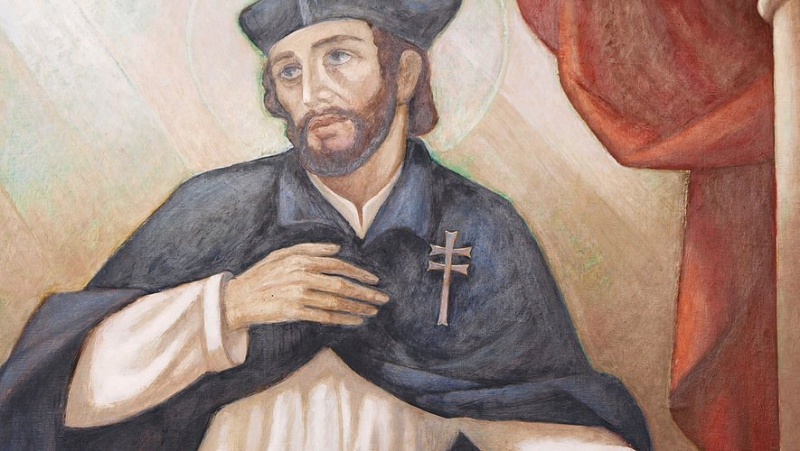Brother Gui of Montpellier, “the Abbot Pierre of the time”, died in 1208, was beatified by Pope Francis

“Il a créé le premier Samu social”, souligne l'historienne Françoise Durand-Dol. DUCHACZKI/CC BY SA
Religieux du XIIe siècle, il avait créé l'ordre du Saint-Esprit. Le pape Innocent III l'avait pris sous son aile. Il a été progressivement oublié. 800 ans après, le Vatican lui rend hommage.
"It's a big surprise as Pope Francis likes to do without much warning and for Pentecost, that's good", smiles Montpellier historian Françoise Durand-Dol. Pentecost, which celebrates the outpouring of the Holy Spirit on the apostles. And on Saturday, at the Vatican, Pope Francis who concedes to the order of the hospitals of the Holy Spirit the cult of the French religious of the 12th century.
Gui of Montpellier (died in 1208), since it is him in question, is now "blessed". This is his title, pending a potential canonization. He is not Saint. He is beatified, recognized for his heroic acts, for having created the order of the Holy Spirit, coming to the aid of abandoned children, the poor and the sick.
He modeled his order on the rules of Saint John of Jerusalem. "He gave a beautiful image of charity, of love of neighbor , it's a bit like Abbé Pierre from the era, insists Father Alain Hees, the archivist of the diocese of Montpellier. "He created the first social Samu, with a cart system that went into town to pick up the poor", complete Françoise Durand -Dol.
He may never become Saint
His beatification is equipollent, that is to say that it was carried out at the discretion of the pope, without requiring proof of miracles. Difficult to obtain traces: Gui de Montpellier has been gone for more than 800 years. He may never become Saint. Or it will be within a few years at the end of a new process. He would then be Saint for the universal Church, and not on the scale of a diocese or a religious community.
The news of the beatification of the Montpellier was surprising, the diocese not having been taken into confidence. It must be said that the initiative comes from sisters of her order, from Poland. They are the ones who took charge of this request.
Already in the 1990s, Pope John Paul II, also of Polish origin, was concerned about this brother Gui who had fallen into oblivion. The then bishop of Montpellier, Louis Boffet, was sensitive to this. A professor of medieval history, Daniel Le Blévec, also pleaded for rehabilitation. And it was Françoise Durand-Dol who took up the challenge. She published her thesis on the subject in 2011 and has continued to deepen her subject ever since.
From the line of Guilhem, the lords of Montpellier
Gui de Montpellier has not yet revealed all his mysteries. He would descend from the line of Guilhem, the lords of Montpellier. "There is no proof of his identity but the only valid hypothesis is that he was a younger son of William VII and Mathilde of Burgundy", specifies Françoise Durand-Dol.
The hospital and the hospital religious community that he created around 1190, at the time outside the walls of Montpellier, were below the current Corum. During the wars of religion, the hospital was burned down in 1561 and then razed. Remains were found in 1998 during excavations for the tramway. A small part of the ruins of the chapel has been reassembled. It is still visible, very close to Corum.
"Georges Frêche, the mayor of Montpellier, told us in 1998 "If you obtain a beatification, I will make an avenue or a place for him her name in Montpellier", we all laughed", says the historian.
"In Rome, Gui has a lot of credibility"
The community was open to the city, bringing together brothers and sisters. This originality pleased Pope Innocent III, who had knighted the order in 1198 and who asked Brother Gui in 1201 to direct the Roman hospital of the Vatican, which took the name of Holy Spirit as in Montpellier. The birthplace of the Santo Spirito in Saxia hospital is therefore Languedocian.
"In Rome, Gui has a lot of credibility because he is contemporary with the prestige of medicine in Montpellier& ;quot;, adds Father Hees. Over time, the Montpellier hospital became the commandery of several communities spread across Europe. The order of the Holy Spirit had become Roman and remained so for the following centuries. The Church of France and the Royalty beat him cold. And the chapter of Maguelone, which reigned religiously in Languedoc, "conservative, looked with distrust at this extremely innovative foundation< /em>", emphasizes Françoise Durand-Dol.
Brother Gui was gradually forgotten. We had to wait a few more centuries for it to return with the odor of holiness. It was Saturday at the Vatican.
Another presence in Languedoc
Demonstrations took place in Montpellier in 1998 for the eighth centenary of the recognition of this order by the Pope, in the presence of sisters from Poland, Spain and France.
A secular community was created in 1999, following the charism of Gui de Montpellier.
Since the fall of 2021, a community of Polish sisters of the Order of the Holy Spirit has settled in Marvejols, near a former hospital of their order of the 12th century.
A rue Gui de Montpellier exists in Palavas-les-Flots.
A conference by Françoise Durand-Dol will be organized in Montpellier in June, without the date being set yet.
I subscribe to read more




